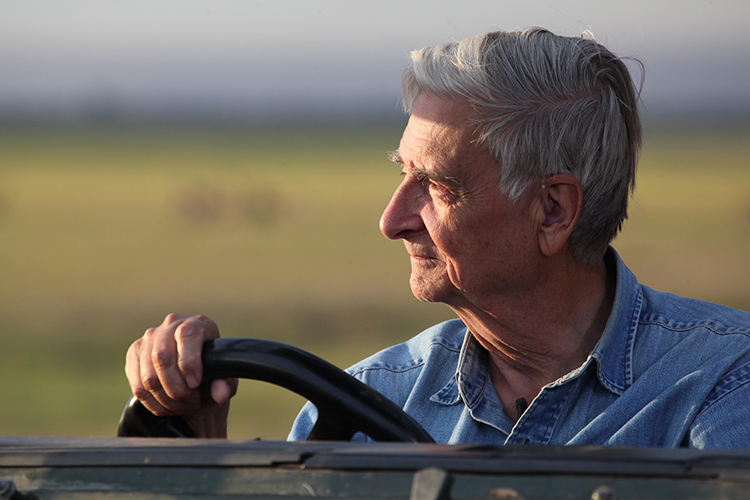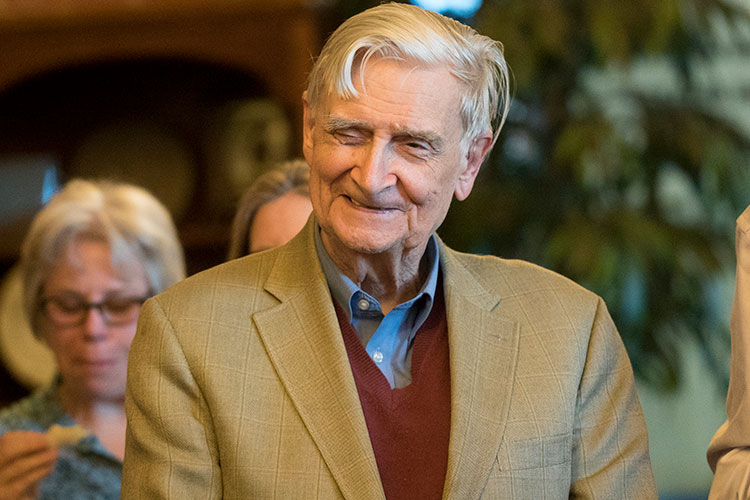Naturalist E.O. Wilson on the fight to save half the planet for wildlife
Renowned biologist and author to visit campus Monday to celebrate third annual Half-Earth Day
October 3, 2019

Renowned naturalist and author E.O. Wilson will speak on campus Monday as part of the third annual Half-Earth Day conference. (Jay Vavra photo)
To save Earth’s stunning biodiversity, we need to set aside at least half the planet’s lands and oceans for conservation.
That’s the argument made by naturalist and author E.O. Wilson in his 2016 book Half-Earth and also the inspiration behind the E.O. Wilson Biodiversity Foundation’s Half-Earth Day, an annual event that explores how conservationists of all stripes can make progress toward this lofty, but attainable, goal.
Half-Earth Day will be held at UC Berkeley this year and feature lectures, panels and workshops on education and citizen science, science and technology, conservation and community, and business and sustainability — all culminating in a keynote lecture by Wilson and Sally Jewell of The Nature Conservancy.
Berkeley News spoke with Wilson about the goals of the Half-Earth Project, what it has accomplished since its founding and what we can do to get involved.
Berkeley News: Why do you want to save half of the Earth? Where did that amount come from?
Wilson: That comes from a study that I did quite a few years ago, and which has since been substantiated, concerning the area of a reserve put aside for wildlife and the number of species that can live there indefinitely. For example, if you save 10 percent of an area for native wildlife, animals and plants, you might be able to save 50 percent (of the biodiversity). This is from field data, and it’s substantiated by careful analytic work that I did with another scientist 50 years ago.
Now, suppose we decided to save 85 percent of the plant and animal species. How much land would you need? The answer is one-half. By saving one-half, we can save 85 percent of the biodiversity.
What would it mean to set aside half the Earth? Do humans have to abandon that land entirely?
It doesn’t mean that half the Earth would go over to something like the U.S. national parks, where people aren’t expected to live and carry on trade or anything else. It would include areas with human occupation. For example, it could include some (areas) where people are already preserving most of the wildlife by using very careful agriculture or running a fishing industry that is balanced and doesn’t wipe out species.
So, this can be done. There are a number of countries that are approaching that area right now. Before the disaster in the Amazon and opening the Amazon to exploitation, I had it pointed out to me by the Brazilian minister of the environment, who told me, ‘We’re already there.’ That was when large amounts of the Amazon had been set aside. Now, of course, that’s changing.
But it’s not as difficult to achieve as you might immediately think. We’re not talking about strictly run national parks. We’re talking about areas that are treated as very special because of their fauna and flora, and where priority is given by the people living there to maintain a full complement of native animals and plants.
Are any other countries making substantial progress toward the Half-Earth goal?
One country I’m very much involved with is Mozambique. Mozambique, with Gorongosa National Park, has set aside easily that amount.

Wilson visited campus in 2015 to deliver the keynote address at Berkeley’s centennial conference on science and the National Park Service. (UC Berkeley photo by Jim Block)
For the Half-Earth goal to be met, you will need a significant number of the 195 countries in the world to get on board. How do you tackle that challenge?
Well, there are 195 countries at the present time that are not engaged in all-out war with their neighbor, for example! This is a potentially universal, humane, healthy goal for countries to make, because they will save their heritage, they will save lives, they will save their environment, and they can make it as part of an agreement to control atmospheric change. I think that’s what’s been accomplished, to some extent, and it has the prospects of being achievable.
It’s been three years since the publication of your book, and this will be the third anniversary of Half-Earth Day. What has the book accomplished that you are proud of?
Right from the time of the publication of the book, the argument was solidly accepted. That was evident at the last meeting of the International Union for Conservation of Nature, when speaker after speaker, and the head of organization after organization, stated that this was probably the best goal we could have, and to go for it. So, this acceptance of a somewhat radical goal, to save the earth’s fauna and flora, I think has been the best achievement of the book.
The Half-Earth Project website contains an interactive map illustrating biodiversity hot spots throughout the world. What is the importance of identifying these areas?
Whenever a hot spot is identified, an area that has the highest number of species found nowhere else, that country has a double incentive to keep it safe and to keep it part of a reserve. So, a big part of the future of conservation biology is going to be to continue studies of what the species of plants and animals are around the world and where they are found.
We’re just starting that process. It turns out there are something like 2 million species of plants and animals known to science at the present time, but the total number of species that are on the earth is estimated to be about 10 million. So, we probably still have not yet identified half or more of the species of plants and animals in the world. And as we learn more and more of them and see which ones are scarcer and which ones are concentrated in certain places, in different countries, then it will be possible to readjust protected and special areas accordingly, and I think with a much higher yield of conservation.
There may even be some gerrymandering. I know that’s a word that’s not bandied about with great fervor, but in the case of planning reserves and special areas for conservation, gerrymandering could be a very fruitful technique. You take a piece here and a sliver there, and then a little round area over here, and you put them together into a national reserve or protected area, and you can get a lot more than if you just took what was available politically and geographically.
Do you have a favorite hot spot or conservation area?
I’ve never been to an area that I didn’t fall in love with, where I didn’t think, “We’ve got to save this.” Statistically, there are places that have more species than others. But in almost every country around the world, there are places where natural environments have been saved, and that’s where you can still find a substantial number of plants and animals, including some that are threatened.
In light of all the bad news about the biodiversity crisis and the sixth extinction, how do people keep up hope? And what can people do?
I think what people can do is seize opportunities locally and contribute, if they can, both with their voices and donations, to the most effective conservation organizations and reach out to whatever country they would like to help. In many ways, it’s an extension of the way we’ve always done conservation, but now in a better informed way, with more confidence that we are getting results that will last forever.
The learn more about Half-Earth Day 2019 or purchase tickets, visit https://www.half-earthproject.org/half-earth-day-2019/